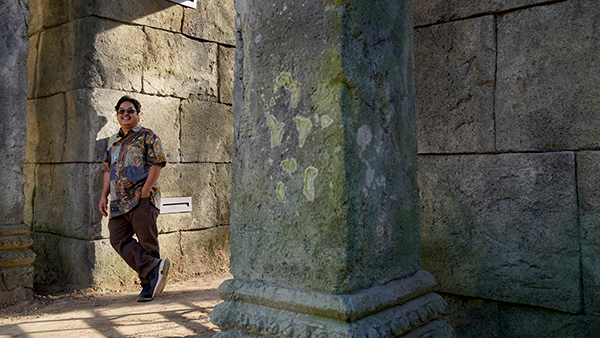Dr. W. Saam Noonsuk served as a cultural adviser on the Fresno Chaffee Zoo's new Kingdoms of Asia exhibit which opened on June 3. The partnership was featured in the fall 2022 issue of Fresno State Magazine.
Gazing up at the intricate rockwork beneath the remnants of an ancient Cambodian temple, a group of students follows its professor through the entryway as if it’s a portal into another time and place. The dense jungle landscape has reclaimed the temple, with trees sprouting high atop the structure and roots as thick as boa constrictors seemingly squeezing the stone façade into submission. As birds chirp and siamang apes sing nearby, the group scans the horizon, wary of predators. Just a few feet away is a gently flowing stream, known as a popular watering hole for Malayan tigers, and home to the Sunda gharial, a large crocodilian species. What an adventure this is going to be.
This Southeast Asian jungle habitat is only miles away from the Fresno State campus. It’s part of the new Kingdoms of Asia exhibition at the Fresno Chaffee Zoo.
“It’s beyond words, it’s so impressive,” says Dr. W. Saam Noonsuk, an art history professor who served as a cultural adviser for the new exhibition. “It looks real. It’s quite authentic. This project will be transformative for my students because they don’t have these types of temples around Fresno.”
Similar in scope to the zoo’s popular African Adventure exhibition that opened in 2015, Kingdoms of Asia was scheduled to open to the public in February 2023. In addition to tigers, orangutans and Sunda gharial, it will include sloth bears, Asian small-clawed otters and a new habitat for the Komodo dragon.
The impressive surroundings, inspired by Southeast Asian temples such as Bayon and Ta Prohm from 12th and 13th century Cambodia, are all part of the experience envisioned by Fresno Chaffee Zoo leadership. The detailed rockwork is similar to the scenic design one might expect of a Disneyland attraction, transitioning visitors into another era.
“It looks beautiful,” Noonsuk says. “There are big trees, there are roots intertwined into the ruins, and it looks like the place was reclaimed by nature.”
Visit Fresno State Magazine to read more.
|


